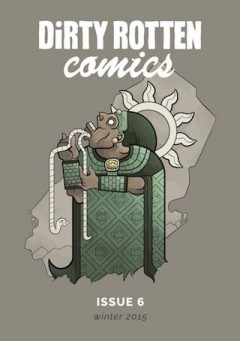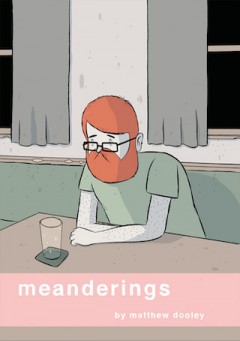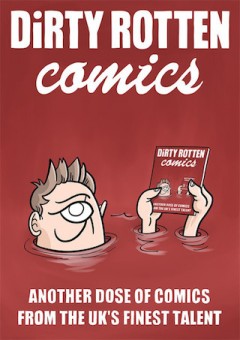“We wanted to help get British comics out to a wider audience” Dirty Rotten Comics’ Gary Clapp on indie anthologies and Throwaway Press
 Mixing sharp satire with surreal nonsense, Dirty Rotten Comics is the coolest small press anthology out there. Along with Meanderings, a short collection from artist Matthew Dooley, they make up the roster of the newly formed Throwaway Press and we catch up with editor Gary Clapp to find out why you definitely shouldn’t be discarding either of these amazing indie collections.
Mixing sharp satire with surreal nonsense, Dirty Rotten Comics is the coolest small press anthology out there. Along with Meanderings, a short collection from artist Matthew Dooley, they make up the roster of the newly formed Throwaway Press and we catch up with editor Gary Clapp to find out why you definitely shouldn’t be discarding either of these amazing indie collections.

Tell us a bit about the inspiration for indie comics anthology Dirty Rotten Comics (and where did the name come from?)
Gary Clapp: The British comics scene has really flourished over the past few years, and there is so much great content out there which isn’t necessarily being given the exposure it deserves. Dirty Rotten Comics came about as a response to this. We wanted to help get British comics out to a wider audience, and an anthology-format book felt like the best way to do it. As creators ourselves, we were put off by the various niche titles which did exist, so wanted to make a book that was accessible and diverse in content and tone. We’ve always tried to be as inclusive as we can, so will often include first-timers or previously unpublished creators alongside bigger names in the scene.
As for the name – I honestly have no idea!
How do you select which stories go into each issue? Do artists pitch to you or do you approach them for work?
GC: Once our submissions window has closed, we usually spend an evening or two down the pub, hacking together a structure and page order. As we’ve grown over the past few years, this has become exponentially harder as we receive a great deal more submissions than we are able to include. It’s a good position to be in, though, as we can ensure that the final book maintains a really high quality.
We will occasionally take story pitches, but more often than not we receive submissions in their final form. We have approached a number of artists in the past for strips – usually this will be as a result of stumbling across someone’s work on Twitter or Instagram, and reaching out for a comic.
It’s a pretty eclectic selection of stories, do you give them any guidance on submissions?
GC: None at all. We try to interfere as little as possible, and let people create the work that interests them. We feel that themes can be restrictive in this regard, and we enjoy the challenge of crafting a coherent book from pieces that may be pulling in different directions.

Are there any stories you are particularly proud of in this issue or creators you have been particularly proud to get involved?
GC: Without wanting to dodge the question, I’m proud of the entire issue! Certainly it feels like the best and most coherent book that we’ve put out to date.
If I were to choose one stand-out strip, it would be Andrew Warwick’s ‘The Laundry Goblin’, as his particular brand of gritty horror ticks all the boxes for me. I approached Andrew for a strip having read The Grinning Man last year, and he didn’t disappoint.
We’ve worked with some great people in the past, but Kirk and I were particularly starstruck when Barney Farmer & Lee Healey sent us a comic for issue 4. We’ve always been fans of their work in Viz, so it was a tick off the bucket list having them involved in DRC.
You’re also branching out into publishing other comics via Throwaway Press? What made you choose to expand your empire?
GC: There’s definitely a growing market for indie comics, and it felt like the next logical step to start publishing books outside of DRC. We were certainly encouraged by the success of publishers like Avery Hill, who are doing some really great things at the minute. There’s a lot of enthusiasm in the scene, which is going through something of a golden age. If we can capture that energy and help other creators to publish and sell their work, then so much the better.
The first Throwaway book is Meanderings from Matt Dooley, why did you choose him for your first non-DRC book and what was it about Meanderings that made you think it would be a strong collection to put out?
GC: When Kirk and I initially discussed the idea of publishing other books, it felt natural that we would publish people that we had worked with previously. We’ve known Matt for a couple of years now and his comics are consistently great, having been a staple in the pages of DRC since our third issue. At the point we approached him, Matt had already started work on Meanderings, so it all fell into place very easily.

Matt has such a distinct voice; his strips are often very funny but are anchored in a kind of bleak British sensibility. Meanderings collects a range of work he’s done over the past few years, and as soon as we read it we knew it’d be a great first project for Throwaway Press.
The production values on DRC (and Meanderings) are second to none, how important is it for you to have really great printing? And does that help you stand out in the small press scene?
GC: It’s vital! I don’t think there’s any point in putting out a book unless the production values match the content in terms of quality. The print options available to self-publishers now are so much better than they were even five years ago, which has meant we don’t have to charge too much for our books, while still retaining a level of quality that keeps us attractive.
Certainly more and more people on the small press scene are becoming aware of the opportunities in print, and the standard of material you’ll see at fairs or conventions has dramatically increased in the last few years. Nonetheless it’s definitely given us an edge, which validates the countless hours I’ve spent obsessing over paper-weight and cover stock.
Any plans to expand into the world of digital comics?
GC: Yes, absolutely! We need to work out an arrangement that’s sensible for us financially, but it’s the next item on our agenda.

Why do you think the Small Press scene seems to be thriving so much at the moment?
GC: One of the best things about comics is there’s such a low barrier for entry, that almost anyone can pick up a pen and throw together a comic. This has always kept the community diverse and relatively free of the cultural policing that takes place in other forms of media. It also means – blessedly – that there are fewer ‘gatekeepers’ holding the keys to entry, so anyone can find a voice and audience.
The internet has been great in this regard, as social media has made it possible for artists to get their work out to a much larger community with relative ease. Certainly, Twitter has been invaluable for us in capturing a new market and getting people involved with comics who may have never given serious thought to the medium before.
There are also many more illustration and creative graduates now, and a lot of the new blood we’re seeing in the scene is coming from people trained in these disciplines. I wonder whether it’s a response to the competitive jobs market, but more and more people are realising the potentials of self-publishing, and that’s absolutely reflected in the breadth and quality of material available on shelves today.
What can we expect from DRC and Throwaway next?
GC: We’re already gearing up for the next issue of DRC, due out late-summer, and have some more stand-alone books in the pipeline which we’ll be announcing in due course. Outside of that (once we’ve caught a breath!), we’re putting together some hush-hush projects to launch by the end of the year, which are incredibly exciting but taking up a lot of our time.



Dirty Rotten Comics – UK Comics Anthology » DRC’s Gary & Kirk Interviewed
May 9, 2016 @ 5:43 pm
[…] Posted on May 9th, 2016 […]
December 21, 2025 @ 11:23 am
Dimitrios Zuhause ist das Albany House, eine weitläufige,
roséfarbene Luxusvilla direkt am Strand gelegen, auf New Providence Island,
Bahamas. Regie führte Martin Campbell, der schon Craigs
Vorgänger Pierce Brosnan mit „GoldenEye“ zu einem erfolgreichen Start als James Bond verhalf.
2006 gelang ihm mit „Casino Royale“ der endgültige internationale Durchbruch.
Von dieser h�tte Le Chiffre durch spekulative Aktienk�ufe millionenfach profitieren k�nnen, aber 007 hat ihm einmal mehr gr�ndlich die Tour vermasselt.
Leider kommt ihm da 007 in die Quere und verhindert nach einer halsbrecherischen Verfolgungsjagd auf der Start- und
Landebahn des Airports in allerletzter Sekunde die minuti�s geplante Katastrophe.
Scheinbar unger�hrt entschwindet Bond mit dem Lift …
Die Website wurde 2002 von 2 Bondfans aus Deutschland und Österreich
gegründet und informiert seither tagesaktuell und
kompetent über James Bond 007.
References:
https://online-spielhallen.de/greatwin-casino-deutschland-deine-top-adresse-fur-online-glucksspiel-in-deutschland/
December 27, 2025 @ 1:26 am
With their alluring mechanics and prospects of scoring a jackpot, users search for strategies to improve their pokie machine experience.
The comprehensive benefits of high roller programs ensure punters receive premium
treatment and rewards commensurate with their level of play.
Although phone support offers numerous benefits, it is important to
acknowledge the potential challenges that may arise. Exceptional customer
support is a hallmark of a reputable casino. However,
it is crucial to carefully read the terms and conditions of these offers to understand
any wagering requirements or restrictions. We’re here to answer all your questions and provide
insights based on our extensive knowledge and research in the field of virtual gambling.
The best online casinos in Australia offer bonuses to attract new players.
The best online casinos prioritize high-quality games from renowned
providers, ensuring a premium gaming experience. Australian online casinos offer a diverse range
of games to cater to various player preferences.
The Australian Communications and Media Authority is responsible
for governing the gambling market in Australia. Since its establishment
in 2020, Las Atlantis has gained widespread appeal across Australia,
particularly resonating with gaming enthusiasts in New South Wales and Victoria.
For assistance, the platform excels with its readily available customer service, accessible
through both live chat and phone support. While some may yarn about which casino tops the charts in Australia, Ricky Casino certainly throws its hat in the ring with confidence.
December 27, 2025 @ 12:09 pm
You can play on smartphone the same 4000+ games, activate bonuses, make payments and contact support, just like on the desktop version. Minimum deposits start at just A$30 for
most methods, making our platform accessible to casual
players while supporting high-roller transactions up to
A$7,800 per deposit. All our options, such as registration and login, deposit and withdrawal,
casino games and live casino, are fully accessible.
And if a platform ticks all the boxes – like clear licensing, fast payouts, top games, mobile access, and real customer support – you’re
already ahead of the game. With 24/7 access to a massive library of top-tier pokies, classic
table games, and immersive live casino experiences, the action never stops.
The platform supports diverse payment channels catering to different
player preferences for deposits and withdrawals.
Players are notified in advance of any standard payment system fees that
may apply. Specific odds for each category are specified in the welcome bonus terms and conditions.
Information about future releases will appear on the official
casino website. Currently, an adapted mobile version of the site with full functionality is available.
Maximum deposit amounts differ for bank cards, e-wallets and cryptocurrencies.
References:
https://blackcoin.co/microgaming-casino-bonuses-and-how-they-work/
December 29, 2025 @ 5:47 am
casino online uk paypal
References:
divyangrojgar.com
December 29, 2025 @ 6:05 am
paypal online casinos
References:
https://onism-eg.co/employer/us-online-casinos-that-accept-paypal-2025/